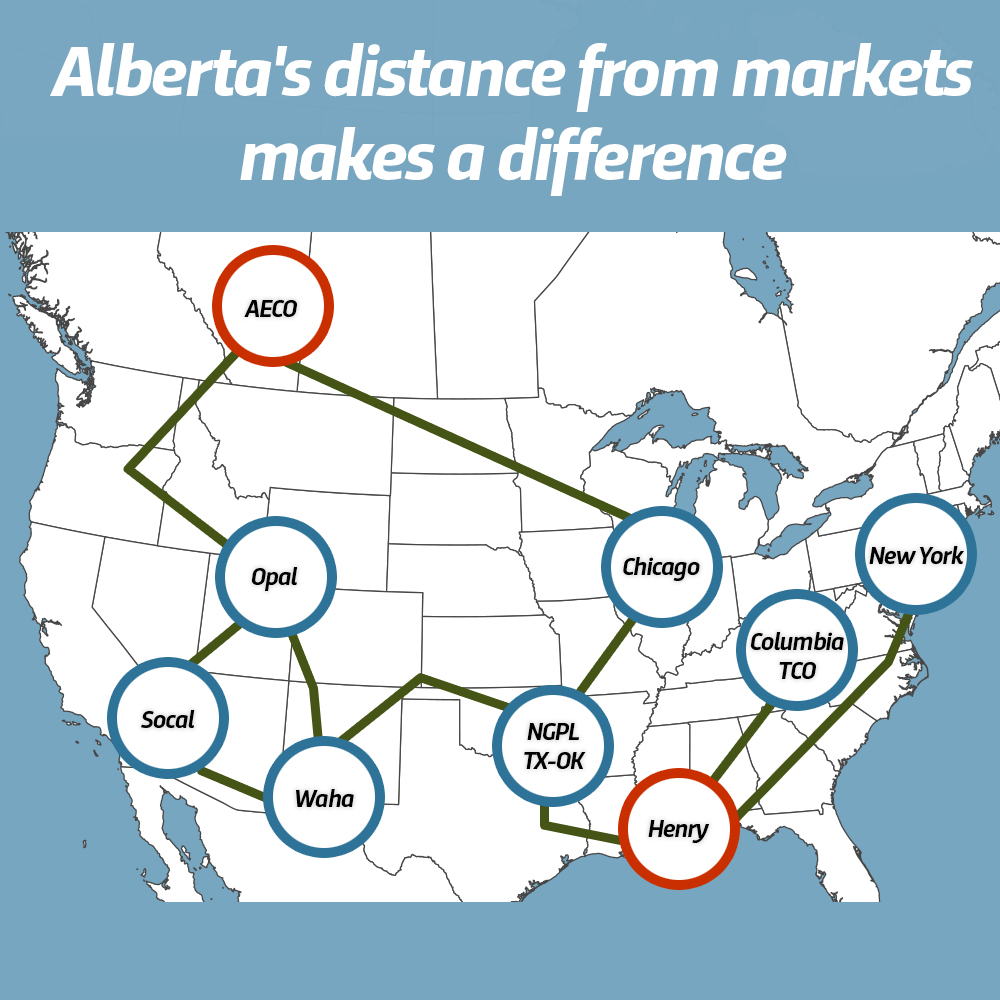Alberta’s distance from markets makes a difference

Like the price we receive for our oil, the price that we receive for our natural gas is different than the prices you might hear quoted in business reports. But unlike oil, it’s not because Alberta is producing a different type of product.
What we commonly call “natural gas” is largely composed of methane. There are not different grades of methane, unlike oil.
Instead, the difference in price is related to how far Alberta is from major natural gas markets – which, not surprisingly, are in the United States.
It’s important to remember that natural gas prices are more continental than global in nature.
As a commodity that is a gas in its natural state, natural gas is harder to export overseas than oil. Before it can be shipped in a tanker, it has to be sent through a liquified natural gas (LNG) facility, to be converted into a liquid. At the present time, there are limited LNG facilities in North America.
Natural gas markets are also highly integrated. There is an extensive network of natural gas pipelines in Canada and the U.S. This enables natural gas to move across North America quite freely.
So although they are influenced by global prices, natural gas prices in North America are largely based on supply and demand within the continent.
A major benchmark price for natural gas in North America is “Henry Hub”. This price is based on delivery of natural gas to a hub near Henry (a rural hamlet near Erath, Louisiana). This is a distribution centre connected to 16 major gas pipeline systems that draw supplies from the region’s gas deposits. The pipelines serve markets throughout the US East Coast, Gulf Coast and Midwestern US.
Geographically, Alberta’s natural gas fields are much further away from major U.S. markets than new U.S. shale gas supplies that are being produced, and so it costs more to transport our natural gas to those markets.
To move their gas through pipelines, natural gas producers pay tolls to pipeline companies.
Because pipelines are usually natural monopolies, tolls are regulated by agencies similar to Alberta’s Energy Regulator or the National Energy Board. These agencies are established by governments through legislation. The legislation generally requires that the regulatory agencies ensure pipeline tolls are just and reasonable to protect all shippers, whether they are producers, marketers, or end use-customers.
As a practical matter, the regulatory agency needs to ensure that pipeline companies can earn a reasonable return on their investments. (Otherwise, investors would not provide the necessary capital to build, maintain and operate pipelines.)
Most pipeline tolls are distance based — the farther a shipper needs to send their gas, the higher the toll they must pay. Alberta is a long way from Erath, Louisiana, and our province sells its gas into markets that are priced at the Henry Hub benchmark, less transportation costs. As a result, the price Alberta receives for its natural gas — called the AECO price — is discounted to the Henry Hub price.

What does this mean for the royalty framework?
Well, royalties are about Albertans (as owners) getting the value of our resources when they are produced and sold. The amount of value depends on the price we receive for our resources, and what it costs to produce and transport them. The lower the price we receive for our natural gas, the less value there is. Right now, that price is lower than it was in the early 2000s and there is continuing downward pressure on that price.
High volumes of U.S. shale gas production have contributed to a collapse in gas prices generally. Put simply, there are ample supplies of natural gas being produced in North America, relative to demand.
Further downward pressure has also been placed on Alberta’s natural gas price because of rising unit transportation costs. Some natural gas pipelines in Alberta (and major connecting pipelines to markets outside of Alberta) are not as full as they could be. The costs associated with pipeline services generally include higher fixed cost components. When the volume of gas going through a pipe decreases, these fixed costs are spread over a smaller volume, and so they are higher on a per-unit basis.
The bottom line is that due to reduced gas production and lower gas prices, Alberta’s natural gas royalties in 2014-15 were $989 million, compared to their peak of $8.4 billion in 2005-06.
Source: Alberta Energy